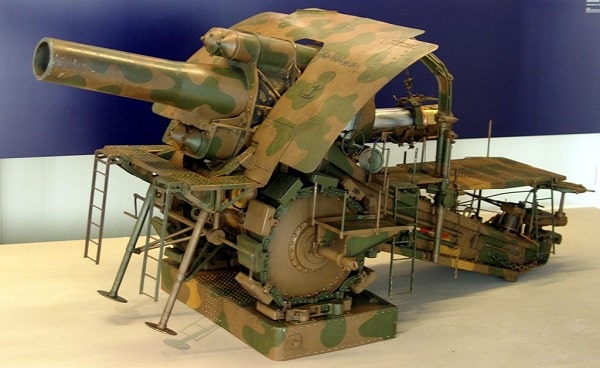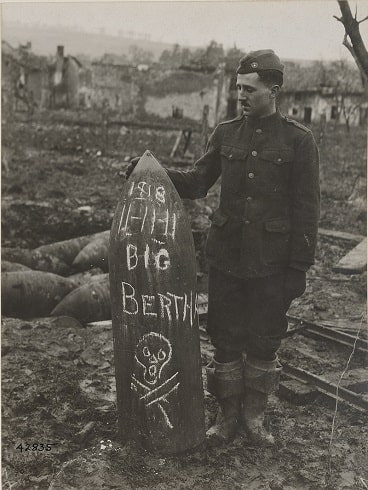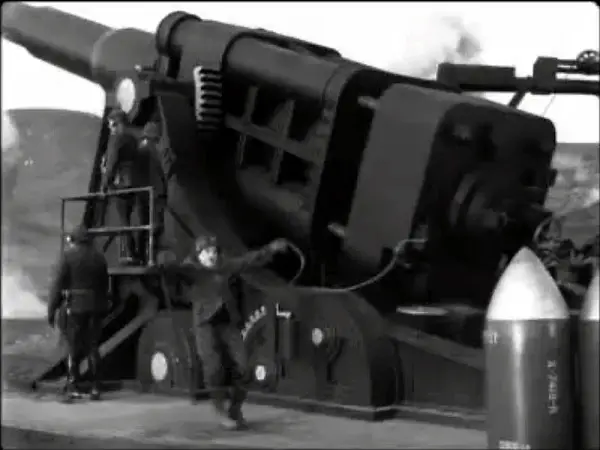Big Bertha, also known as the German Dicke Bertha or M-Gerat, was a 420-mm (16.5-inch) howitzer model. It was employed by the German Army to attack Belgian and French garrisons during World War 1.
According to some sources, the nickname “Big Bertha” was given to the cannons in honor of the Krupp firm’s owner, Bertha Krupp von Bohlen und Holbach.
Krupp AG developed it in Germany – Essen and was operated by the German Army between 1914 and 1918.
German soldiers dubbed the gun “Big Bertha” after one bullet obliterated Fort Loncin. The troops used it during the artillery bombardment of Liège, Belgium.
A total of 12 Big Berthas were deployed. The M-Gerät was one of the heaviest pieces of artilleries ever handled with a 42-centimeter (17-inch) gauge barrel.
The initial test of the Big Bertha was done in 1911 but was taken into the production process and completed in October 1912.
However, two of the available Big Bertha guns were still in the prototype stages even after the breaking out the major war, World War 1. Nevertheless, troops transferred them to Liège.
The troops used them to demolish Loncin and the Forts Pontisse.
The fancy name for the weapon- “Big Bertha,” swept through the German press and was adopted as the German transuranic artilleries nickname.
Likewise, the Paris Gun has also historically been mistaken for the Big Bertha or the M-Gerat. Germans deployed Paris Gun; after all, Big Berthas were retired in 1918.
Similarly, German engineers consequently produced a smaller-caliber cannon due to casualties from defective ammunition.
German troops operated the smaller-caliber cannon starting from the year 1916 and lasting until the war ended.
Although smaller in caliber, it possessed a lengthier and bigger barrel. Engineers fitted the barrel to the chassis of the M-Gerät. However, it was not as accurate as the base guns used during that period.
What happened to the Big Bertha gun?
Content
The Germans surrendered two 42 cm M-Gerät guns, a.k.a. Big Berthas, to the US Army at Spincourt in November 1918.
What is the biggest gun in history?
The biggest gun in history was not Big Bertha, but the Gustav gun. The Germans created it, and it had an 80cm barrel. The Germans first used this gun in World War 1.
Is Big Bertha still used today?
None of the Big Bertha cannons exit today. The Germans’ last use of these guns was against fortresses in 1914 and 1915. Germans built twelve Big Bertha guns in the war, but Germans lost six due to barrel failure.
The Design and Development of Big Bertha

The rapid progress of cannon technology sparked the arms race between the constructions of the artilleries and the militaries from the early 1850s.
The artilleries, especially the rifles, were able to shoot beyond the cannon’s fortress range. In response, military planners began constructing garrisons in rings encircling cities.
They also constructed garrisons as barriers to prevent oncoming military troops.
The available forts were susceptible to artillery projectiles that could puncture the earth and demolish subsurface masonry.
As a result, the star-shaped forts morphed into forts with polygonal shapes. The morphed strongholds were largely underground and composed of concrete.
The weapons were also positioned in armored, spinning casemates. France had established a massive fortified region around the border with Germany by combining rings and barriers.
Likewise, by 1888 Belgium had also begun building the National Redoubt, during which the Germans strengthened their frontiers.
However, Helmuth von Moltke – the elder, the General Staff’s Chief- demanded the ability to breach Franco-Belgian defenses. German had stagnated despite being efficient during the War of Franco-Prussian.
The barrel radius of one of the powerful cannons of German troops, the 21-cm howitzer, could not result as the appropriate cannon against the strongholds.
Thus, Moltke then started demanding more powerful firearms during the same decade.
Consequently, in retaliation to the 1893 Franco-Russian Alliance, Alfred von Schlieffen, who was Moltke’s successor, sought to win over France by pushing through Belgium speedily.
In 1893, the commission of the Artillery Test – APK, created an alignment with the Krupp AG to lower the size of the strongholds of both France and Belgium,
The first product of this collaboration was a mortar labeled as the Schwerer Küstenmorser L/8 with a total length of 30.5 centimeters. However, the troops dubbed it the Beta- M- Gerat to mask its use as cannons used for the siege.
The combined contribution from APK and Krupp produced a mobile howitzer named Kurze Marinekanone 14 L/12, with a total length of 42 centimeters in the year 1911.
Along with this, the Commission of Artillery Test also commissioned two more of such kinds, the 1st M-Gerat in 1912 ( July ) and the 2nd one in 1913 (February).
Finally, in 1913 (December), gun portability tests began. Engineers discovered that tractors with gas powder were optimal for towing the famous M-Gerat.
At last, in 1914 (February), test-firing commenced and was witnessed by one of the Military leaders, Kaiser Wilhelm II.
Production

The total weight of the Big Bertha was about 42.6 metric tonnes. This giant weapon stood at 4.5 meters tall 10 meters in length, and 4.7 meters in breadth.
It perched on a base made out of steel and was braced with a wedge. Soldiers could also raise this spade above the ground level, and the Big Bertha was appropriately positioned to help move the spade.
This attribute gave Big Bertha a 360° rotation. The cannon was also breech-loaded with a horizontally movable breechblock.
The Big Bertha consisted of a cylinder with a total length of 5.04 m that could rise to the limit of 65 degrees.
The total velocity of the muzzle after it was discharged was about 815 m per second and could stand off a total distance of around 9,300 m.
Though the APK commissioned the 1st Big Bertha in 1912 (July), it arrived only in December the following year. The APK commissioned the 2nd one again in 1913 ( February ).
A total of 6 guns were commissioned in different periods, two on the 31st of July, 1914, two on the 28th of August, 1914, and the final two on the 11th of November, 1914, making the total 12 Big Berthas.
This weapon was to be installed on-site, dismantled, and hauled in 5 wagons for transfer, where each wagon that weighed between 16 to 20 metric tons was designed to contain a particular segment of Big Bertha.
A carriage of guns with its wagon was excluded as they were over the maximum weight a horse could pull. They were instead hauled by purpose-built, gas-powered tractors.
Under ideal conditions, a wagon and a tractor could travel 7 kilometers per hour. Troops were able to assemble Big Bertha in six hours on the battlefield.
Ammunition

The siege artillery of the Germans consisted of projectiles with the ability to pierce other armor that could be exploded with a very high velocity.
The weapon engineers intended the armor-piercing shell to pierce the strongest armor like the ones built using metals and concretes. But, the available projectile could not act as planned against the concretes that were reinforced.
Likewise, the shells with a high explosion velocity were set under different charges, including no delay, long delay, or short delay.
If they selected no delay the shell exploded on impact, penetrating the ground to the max of 12 m depth.
Likewise, another version, the short shell, which weighed less than the explosive shell, was made for an accurate shot and a good range.
The cannons, with a total length of 42 centimeters, consisted of shells that were about 1.5 meters with an average weight of 400 to 1,160 kilograms.
The artillery shells meant for the siege were manufactured in restricted quantities, which led to a quality gradient.
Hence, the result was the detonating of the German guns due to defective artilleries. And the crews had to evacuate from Big Bertha before firing.
Battle Service

The German Army had only two Big Berthas at the war’s outset. On August 12, 1914, both saw their first combat against the labyrinth of Belgian forts around Liège.
The weapons destroyed a series of forts and forced the city’s surrender in five days.
This allowed the German Army to proceed westward through southern Belgium. They were approaching to conquer northern France.
On August 21–25, the forts surrounding Namur were similarly pounded into submission by Big Berthas and Koda 305-mm mortars.
There were two more victorious sieges: Maubeuge (August 25–September 8) and Antwerp (September 28–October 10).
In 1915, as more Big Berthas (12 guns) were manufactured and fielded, they produced similar success against Russian forts.
However, the Big Berthas could not penetrate the reinforced concrete of the updated French forts. This was at Douaumont and Vaux during the Battle of Verdun in 1916.
Legacy

As aforementioned, early in the conflict, German soldiers renamed the cannons “Dicke Berta” at the Battle of Liège. It was a homage to Bertha Krupp, who had acquired the Krupp factories from her father.
Consequently, the name became jargon for all large German artillery. The German infantry notably used it for the 42 cm guns.
The name also spread to German publications. Subsequently, it found its way to Allied servicemen as “Big Bertha.”
Since then, the word has entered the mainstream consciousness. For example, it is the namesake for a line of Callaway golf clubs.
It is also a satirical French-language magazine- La Grosse Bertha. In November 1918, two 42 cm Germans relinquished M-Gerät weapons to the US Army at Spincourt.
One was transported to the United States for evaluation before being shown at the Aberdeen Proving Ground. The other, though, was abandoned, unassembled in its transit configuration.
Both were decommissioned in 1943 and the early 1950s.
Emil Cherubin, a World War 1 veteran, also made a copy of an M-Gerät. This copy roamed Germany and was featured on a few postage stamps.
Conclusion
Around the latter months of World War 1, Parisians lived in the shadow of a long-range German artillery cannon.
The Krupp armaments firm produced one of Essen’s most dangerous weapons.
Not to mention, Big Bertha was too good a moniker to stay inside German lines. People soon applied the name to any unusually huge heavy artillery pieces.
The French capital suffered an immense psychological impact within striking distance of the German lines.
A total of 320 to 367 shells were estimated to have been fired. The gun could fire at a maximum of roughly 20 shots per day.
Approximately 250 people were murdered. Six hundred twenty were injured, along with significant property loss.
Finally, the weapon was expressly prohibited by the Treaty of Versailles.
